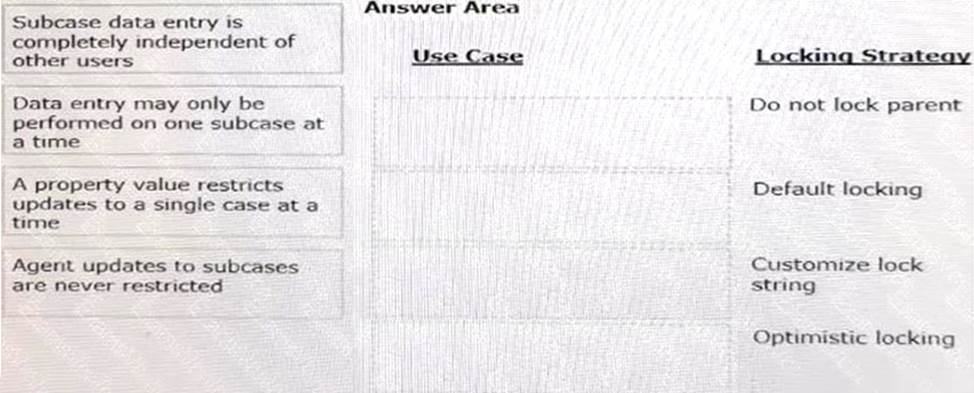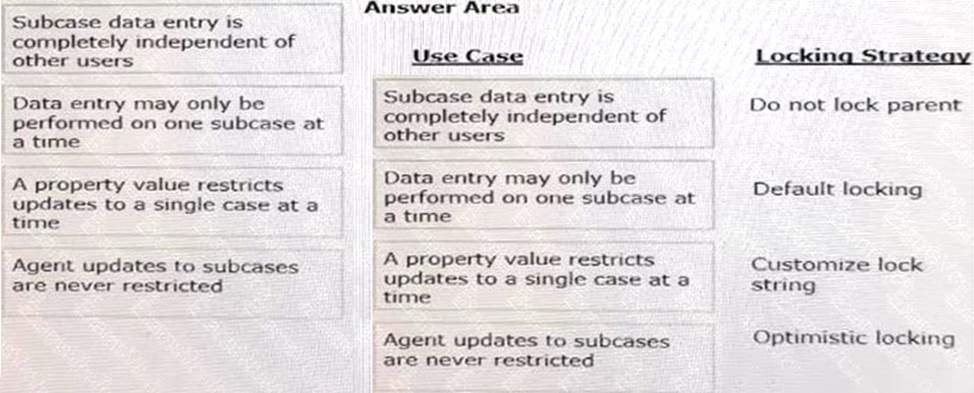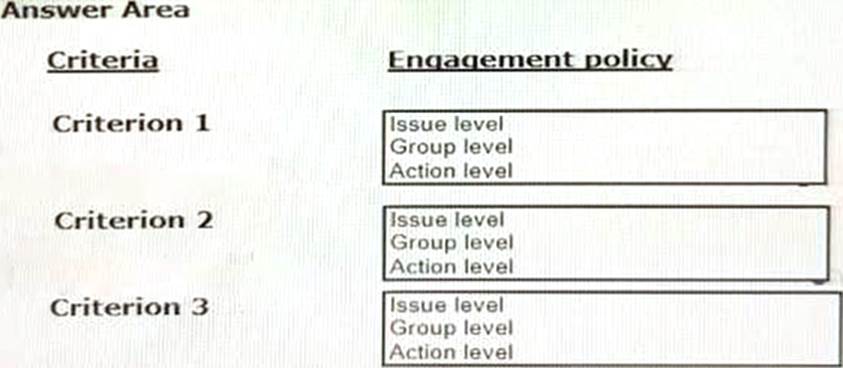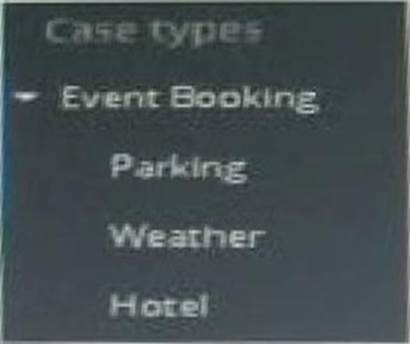Practice Free PEGACPLSA88V1 Exam Online Questions
What two features do activities and functions share? (Choose Two)
- A . Ability to be circumstanced
- B . Ability to be parameterized
- C . Ability to be called directly from a decision table
- D . Ability to be versioned
B, D
Explanation:
Activities and functions in Pega share certain common features which are vital for their flexibility and maintainability.
Parameterization: Both activities and functions can be parameterized, allowing them to accept input values when they are invoked. This makes them reusable in different contexts by simply changing the parameters.
Versioning: Both activities and functions support versioning. This means you can maintain different versions of an activity or function, which is useful for keeping track of changes and ensuring compatibility with different versions of the application.
Reference: Pega Platform documentation on activities and functions.
Customer information is captured in an application. Corporate policy states that private information be secured and only visible to a limited users.
Which configuration do you recommend?
- A . Use a visible when rule for the properties displaying sensitive information.
- B . Create an access control policy restricting access to the sensitive information.
- C . Configure an access deny rule restricting access to the sensitive information.
- D . Move sensitive information to separate sections and apply a privilege to the sections.
B
Explanation:
To ensure that private information is secured and only visible to limited users, creating an access control policy is the recommended approach. Access control policies allow you to define specific conditions and constraints under which sensitive data can be accessed, ensuring that only authorized users can view or modify this information.
Reference: Pega Security: Access Control Policies
Pega Data Security: Securing Sensitive Information
DRAG DROP
In the Answer Area, drag each use case on the left to the appropriate locking strategy on the right.


what configuration is required to control which nodes in a cluster an agent runs.?
- A . assign the agent to a specifie category.
- B . associate the agent to specific node type.
- C . use a custom queue for the agent
- D . create agent schedules on applicable nodes.
B
Explanation:
Node Association: To control which nodes in a cluster an agent runs on, you need to associate the agent with specific node types. This ensures that the agent runs only on the nodes that match the specified type.
Configuration: In the agent rule configuration, specify the node type under the "Node" settings. This allows for precise control over the agent’s execution environment.
Reference: Pega Academy: Configuring Agents for Node Types
Pega Documentation: Agent Configuration and Node Types
HOTSPOT
MyCo, a telecom company, developed a new data plan group to suit the needs of its customers. The following table lists the three data plan actions and the criteria that customers must satisfy to qualify for the offer:

How do you configure the engagement policies to implement this requirement? Choose the engagement policy level that is best-suited for each criterion


Explanation:
Criterion 1: Owns a smart mobile
Engagement Policy Level: Group level
The criterion "Owns a smart mobile" applies to all data plans and can be considered a group-level policy. It filters the audience at a broader level to ensure they have a smart mobile device.
Criterion 2: Under graduation student
Engagement Policy Level: Issue level
The criterion "Under graduation student" applies to multiple data plans (1 GB and 3 GB) and is more specific to the issue of targeting educational segments. Thus, it is suitable at the issue level.
Criterion 3:
Post graduation student
Engagement Policy Level: Action level
The criterion "Post graduation student" is specific to the 5 GB plan and is most appropriate at the action level. This level ensures the targeting is precise for this particular plan. New customer
Engagement Policy Level: Group level
The criterion "New customer" can be applied across multiple offers and thus is suitable for the group level to broadly target new customers. Existing customer
Engagement Policy Level: Action level
The criterion "Existing customer" is applied at the action level to ensure specific offers (3 GB and 5 GB plans) are appropriately targeted to customers who already have a relationship with the company.
Step by Step Comprehensive Detailed Explanation with
Reference: Group Level Engagement Policy:
Conditions that apply broadly across multiple offers or groups of offers fall under group-level policies. Examples include owning a smart mobile and being a new customer. Issue Level Engagement Policy:
Conditions that are relevant to a specific issue, such as educational status for specific data plans, are categorized under issue-level policies. This ensures that offers targeting undergraduates are consistently managed.
Action Level Engagement Policy:
Conditions that are specific to individual actions or offers are best managed at the action level. This includes targeting post-graduation students for the 5 GB plan and existing customers for specific plans to ensure precise targeting.
Reference: Pega’s best practices for engagement policies recommend using group-level policies for broad criteria, issue-level for segment-specific conditions, and action-level for highly specific targeting to ensure effective and relevant customer engagement.
The BigCo quoting application is currently on-premise. BigCo plans to move the application to Pega Cloud.
What factor do you need to consider for environment setup?
- A . Network security configuration
- B . Database access configuration
- C . System management application configuration
- D . Log file access configuration
A
Explanation:
When moving an application to Pega Cloud, network security configuration is crucial to ensure secure communication between the cloud environment and the on-premise systems. Proper network security measures, including VPNs, firewalls, and secure access protocols, need to be established to protect data integrity and confidentiality during and after the migration.
Reference: Pega Cloud Services: Pega Cloud Environment Setup
Pega Cloud Security: Pega Cloud Security Best Practices
Consider the following requirement:
case worker must be able to add a work party when creating a case select the configuration option that fulfills this requirement
- A . add a data transform to the pyCaseManagementDefault work parties rule
- B . Ensure the addparty user action is available as a local action
- C . add the addworkObjectparty activity to the assigments
- D . select the VOE? option on the pyCaseManagementDefault work parties rule
B
Explanation:
Configure Add Party User Action:
Go to the user actions section in the case type configuration.
Local Action Configuration:
Ensure that the addparty user action is available as a local action during case creation to allow case
workers to add a work party.
Reference: Pega documentation on case type configurations and user actions to fulfill work party requirements.
You are working with BigCo to create an application for insurance quoting. BigCo is a multinational corporation that has traded on the NASDAQ as BCO. BigCo headquarters is located in the UK, and the company has division for each geographical location.
You expect the application to contain two types of work: Quote and Policy.
The Quote guides the sales preventative through one or more quote with the customer. Each quote must be retained by the system and visible to the sales representative and the manager, any data captured during the quoting process must be available to the Policy case. The Policy represents the accepted insurance quote.
For the next year, BigCo intends to use the insurance quoting application only for the personal insurance business in the United Kingdom, Joe the business experts (SMEs) to understand the quoting process. Joe uses Pega Express to develop the quoting application with the SMEs. Default application settings are shown in the image.

What two edits do you make to the advanced configuration based on information in the reading passage? (Choose Two).
- A . Deselect ‘’Create demonstration users’’.
- B . Edit the Organization name to BCO.’’
- C . Edit the Organization name to UK’’
- D . Edit the Division name to ‘’UK’’.
- E . Select ‘’Framework’’ as the application structure.
BD
Explanation:
Edit Organization Name:
Go to the application settings in Pega Express.
Edit the Organization name field to "BCO" to match the company’s NASDAQ trading name.
Edit Division Name:
Edit the Division name field to "UK" to reflect the geographical location where the application will be used initially.
Validation:
Ensure that the changes are saved and reflected in the application’s organization settings.
Reference: Pega Academy: Setting Up Your Application.
Pega Documentation: Application Structure and Organization Settings.
Using the information shown in the case structure below, which option is always true?

- A . Resolution of the Event Booking case requires the Parking case to be resolved.
- B . Parking, Weather, and Hotel cases must be instantiated for the Event case to process correctly.
- C . The Weather case can be instantiated without a parent Event Booking case.
- D . The Parking class must inherit from the Event Booking class.
C
Explanation:
To determine which option is always true based on the case structure, let’s analyze each option:
DRAG DROP
BigCo is planning an update to JVM settings on all production nodes at the of the month. The production application supports high availability.
To ensure that users can continue working without distribution while the JVM changes are in process, select and move all of the following tasks to the Task List Order column arrange then correct order.


Explanation:
D, B, C, A, E
